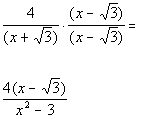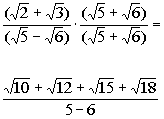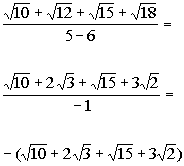Intermediate Algebra
Tutorial 41:
Rationalizing Denominators andNumerators
of Radical Expressions
 Learning Objectives Learning Objectives
|
After completing this tutorial, you should be able to:- Rationalize one term denominators of rational expressions.
- Rationalize one term numerators of rational expressions.
- Rationalize two term denominators of rational expressions.
|
 Introduction Introduction
|
| In this tutorial we will talk about rationalizing the denominator andnumerator of rational expressions. Recall from Tutorial3: Sets of Numbers that a rational number is a number that canbe written as one integer over another. Recall from Tutorial3: Sets of Numbers that an irrational number is not one that ishard to reason with but is a number that cannot be written as one integerover another. It is a non-repeating, non-terminating decimal. Oneexample of an irrational number is when you have a root of an expressionthat is not a perfect root, for example, the square root of 7 or the cuberoot of 2. So when we rationalize either the denominator or numeratorwe want to rid it of radicals. Hopefullyyou will not encounter too many irrational numbers in your life as Frankand Ernest do, but just in case you do, we will help you be prepared forthat moment. |
 Tutorial Tutorial
|
Rationalizing the Denominator
(with one term) |
| When a radical contains an expression that is not a perfect root,for example, the square root of 3 or cube root of 5, it is calledan irrational number. So, in order to rationalizethe denominator, we need to get rid of all radicals that are in the denominator. |
| Step 1: Multiply numerator and denominator by a radicalthat will get rid of the radical in the denominator. |
| If the radical in the denominator is a square root, then you multiplyby a square root that will give you a perfect square under the radicalwhen multiplied by the denominator. If the radical in the denominatoris a cube root, then you multiply by a cube root that will give you a perfectcube under the radical when multiplied by the denominator and so forth... Note that the phrase "perfect square" meansthat you can take the square root of it. Just as "perfectcube" means we can take the cube root of the number, and soforth. Keep in mind that as long as you multiply the numerator and denominatorby the exact same thing, the fractions will be equivalent. |
| Step 2: Make sureall radicals are simplified. |
| Some radicals will already be in a simplified form, but make sure yousimplify the ones that are not. If you need a review on this, |
| Step 3: Simplify the fraction if needed. |
| Be careful. You cannot cancel out a factor that is on the outsideof a radical with one that is on the inside of the radical. In orderto cancel out common factors, they have to be both inside the same radicalor be both outside the radical. |
 Example1: Rationalize the denominator Example1: Rationalize the denominator  . . |
| Step 1: Multiply numerator and denominator by a radicalthat will get rid of the radical in the denominator. |
| Since we have a square root in the denominator, then we need tomultiply by the square root of an expression that will give us a perfectsquare under the radical in the denominator. Square roots are nice to work with in this type of problem because ifthe radicand is not a perfect square to begin with, we just have to multiplyit by itself and then we have a perfect square. So in this case we can accomplish this by multiplying top and bottomby the square root of 6: |
 |
*Mult. num. and den. by sq. root of 6
*Den. now has a perfect square under sq. root
|
| Step 2: Make sureall radicals are simplified AND |
| Step 3: Simplify the fraction if needed. |
 |
*Sq. root of 36 is 6
*Divide out the common factor of 2
|
| Be careful when you reduce a fraction like this. It is real temptingto cancel the 3 which is on the outside of the radical with the 6 whichis inside the radical on the last fraction. You cannot do that unlessthey are both inside the same radical or both outside the radical likethe 4 in the numerator and the 6 in the denominator were in the secondto the last fraction. |
 Example2: Rationalize the denominator Example2: Rationalize the denominator  . . |
| Step 1: Multiply numerator and denominator by a radicalthat will get rid of the radical in the denominator. |
Since we have a cube root in the denominator, we need to multiplyby the cube root of an expression that will give us a perfect cube underthe radical in the denominator.
So in this case, we can accomplish this by multiplying top and bottomby the cube root of  : : |
 |
*Mult. num. and den. by cube root of 
*Den. now has a perfect cube under cube root |
| Step 2: Make sureall radicals are simplified AND |
| Step 3: Simplify the fraction if needed. |
 |
*Cube root of 27 acube is 3a |
| As discussed in example 1, we would not be able to cancel out the 3with the 18 in our final fraction because the 3 is on the outside of theradical and the 18 is on the inside of the radical. Also, we cannot take the cube root of anything under the radical. So, the answer we have is as simplified as we can get it. |
Rationalizing the Numerator
(with one term) |
| As mentioned above, when a radical cannot be evaluated, forexample, the square root of 3 or cube root of 5, it is called anirrationalnumber. So, in order to rationalizethe numerator, we need to get rid of all radicals that are in the numerator. Note that these are the same basic steps forrationalizing a denominator, we are just applying to the numerator now. |
| Step 1: Multiply numerator and denominator by a radicalthat will get rid of the radical in the numerator. |
| If the radical in the numerator is a square root, then you multiplyby a square root that will give you a perfect square under the radicalwhen multiplied by the numerator. If the radical in the numeratoris a cube root, then you multiply by a cube root that will give you a perfectcube under the radical when multiplied by the numerator and so forth... Note that the phrase "perfect square" meansthat you can take the square root of it. Just as "perfectcube" means we can take the cube root of the number, and soforth. Keep in mind that as long as you multiply the numerator and denominatorby the exact same thing, the fractions will be equivalent. |
| Step 2: Make sureall radicals are simplified. |
| Some radicals will already be in a simplified form, but make sure yousimplify the ones that are not. If you need a review on this, |
| Step 3: Simplify the fraction if needed. |
| Be careful. You cannot cancel out a factor that is on the outsideof a radical with one that is on the inside of the radical. In orderto cancel out common factors, they have to be both inside the same radicalor be both outside the radical. |
 Example3: Rationalize the numerator Example3: Rationalize the numerator  . . |
| Step 1: Multiply numerator and denominator by a radicalthat will get rid of the radical in the numerator. |
| Since we have a square root in the numerator, then we need to multiplyby the square root of an expression that will give us a perfect squareunder the radical in the numerator. So in this case, we can accomplish this by multiplying top and bottomby the square root of 5: |
 |
*Mult. num. and den. by sq. root of 5
*Num. now has a perfect square under sq. root |
| Step 2: Make sureall radicals are simplified. AND |
| Step 3: Simplify the fraction if needed. |
 |
*Sq. root of 25 is 5 |
| As discussed above, we would not be able to cancel out the 5 with the30 in our final fraction because the 5 is on the outside of the radicaland the 30 is on the inside of the radical. Also, we cannot take the square root of anything under the radical. So, the answer we have is as simplified as we can get it. |
 Example4: Rationalize the numerator Example4: Rationalize the numerator  . . |
| Step 1: Multiply numerator and denominator by a radicalthat will get rid of the radical in the numerator. |
| Since we have a cube root in the numerator, we need to multiplyby the cube root of an expression that will give us a perfect cube underthe radical in the numerator. So in this case, we can accomplish this by multiplying top and bottomby the cube root of  : : |
 |
*Mult. num. and den. by cube root of 
*Num. now has a perfect cube under cube root |
| Step 2: Make sureall radicals are simplified AND |
| Step 3: Simplify the fraction if needed. |
 |
*Cube root of 8 x cubeis 2x |
| As discussed above, we would not be able to cancel out the 2xwith the 4 x squared in our final fraction,because the 2x is on the outside of the radicaland the 4 x squared is on the inside of theradical. Also, we cannot take the cube root of anything under the radical. So, the answer we have is as simplified as we can get it. |
Rationalizing the Denominator
(with two terms) |
| Above we talked about rationalizing the denominator with one term. Again, rationalizing the denominator means to get rid of any radicals inthe denominator. Because we now have two terms, we are going to have to approach it differentlythan when we had one term, but the goal is still the same. |
| Step 1: Find the conjugate of the denominator. |
| You find the conjugate of a binomial by changing the sign that is betweenthe two terms, but keep the same order of the terms. a + band a - b are conjugatesof each other. |
| Step 2: Multiply the numerator and the denominatorof the fraction by the conjugate found in Step 1 . |
| Keep in mind that as long as you multiply the numerator and denominatorby the exact same thing, the fractions will be equivalent. |
| Step 3: Make sureall radicals are simplified. |
| Some radicals will already be in a simplified form, but make sure yousimplify the ones that are not. If you need a review on this, |
| Step 4: Simplify the fraction if needed. |
| Be careful. You cannot cancel out a factor that is on the outsideof a radical with one that is on the inside of the radical. In orderto cancel out common factors, they have to be both inside the same radicalor be both outside the radical. |
 Example5: Rationalize the denominator Example5: Rationalize the denominator  |
| Step 1: Find the conjugate of the denominator. |
| In general the conjugate of a + bisa- b and vice versa. So what would the conjugate of our denominator be? It looks like the conjugate is  . . |
| Step 2: Multiply the numerator and the denominatorof the fraction by the conjugate found in Step 1. |
 |
*Mult. num. and den. by conjugate of den.
*Productof the sum and diff. of two terms
|
| Step 3: Make sureall radicals are simplified AND |
| Step 4: Simplify the fraction if needed. |
| No simplifying can be done on this problem so the final answer is: 
|
 Example6: Rationalize the denominator Example6: Rationalize the denominator  . . |
| Step 1: Find the conjugate of the denominator. |
| In general the conjugate of a + bisa- b and vice versa. So what would the conjugate of our denominator be? It looks like the conjugate is  . . |
| Step 2: Multiply the numerator and the denominatorof the fraction by the conjugate found in Step 1 . |
 | *Mult. num. and den. by conjugate of den.
*Use FOILmethod in num.
*Productof the sum and diff. of two terms
|
| Step 3: Make sureall radicals are simplified AND |
| Step 4: Simplify the fraction if needed. |
 |
*12 is (4)(3) and sq. root of 4 is 2
*18 is (9)(2) and sq. root of 9 is 3
|
 Practice Problems Practice Problems
|
| These are practice problems to help bring you to the next level. It will allow you to check and see if you have an understanding of thesetypes of problems. Math works just like anythingelse, if you want to get good at it, then you need to practice it. Even the best athletes and musicians had help along the way and lots ofpractice, practice, practice, to get good at their sport or instrument. In fact there is no such thing as too much practice. To get the most out of these, you should work the problem out onyour own and then check your answer by clicking on the link for the answer/discussionfor that problem. At the link you will find the answeras well as any steps that went into finding that answer. |
 PracticeProblem 1a: PracticeProblem 1a:Rationalize the Denominator. |
1a. 
(answer/discussionto 1a) |
 PracticeProblem 2a: PracticeProblem 2a:Rationalize the Numerator. |
2a. 
(answer/discussionto 2a) |
 PracticeProblem 3a: PracticeProblem 3a:Rationalize the Denominator. |
3a. 
(answer/discussionto 3a) |
 Need Extra Help on These Topics? Need Extra Help on These Topics?
|
No appropriate web pages could be found tohelp you with the topics on this page.
for somemore suggestions. |
All contents
Jan. 8, 2002 |